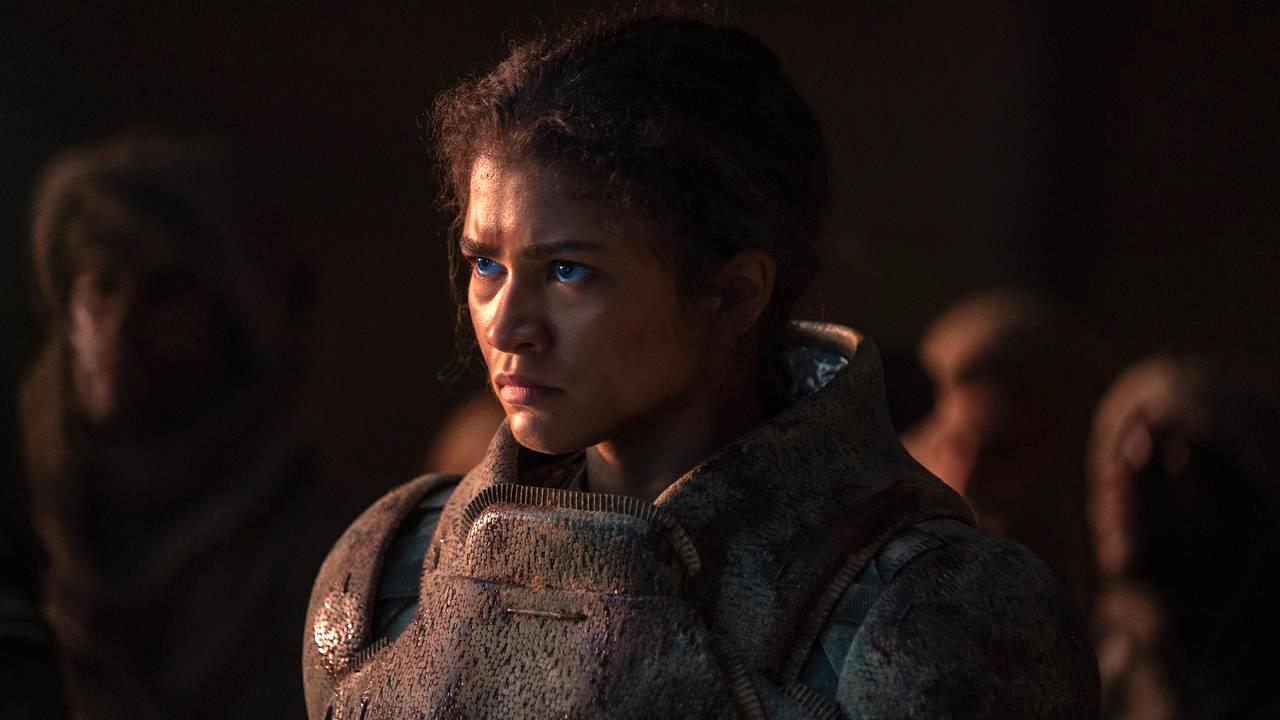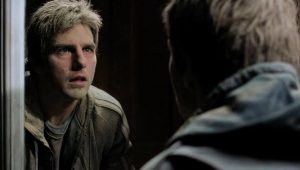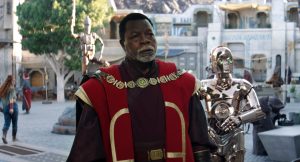
This article contains massive spoilers for Dune: Part Two.
Author and producer Brian Herbert is no stranger to the world of Dune. As the son of Frank Herbert, the visionary writer who published the first Dune novel in 1965, Brian saw firsthand his father create the mythology of Arrakis and the legend of the Kwisatz Haderach. He also would go on to add to that mythology, with Brian co-writing numerous Dune novels of his own. So it should not be taken lightly when he praised this past week the completion of Denis Villeneuve’s two-part Dune adaptation.
“I saw Dune: Part Two at a private studio screening,” Brian Herbert wrote on social media, “and it is gratifying to see my father’s story told with such great care. When the new movie is combined with Dune: Part One it is by far the best film interpretation of Frank Herbert’s classic novel DUNE that has ever been done.”
That’s high praise. It’s also accurate. Herbert’s novel has proven notoriously difficult to adapt over the years. While David Lynch’s compromised 1984 adaptation has its admirers, the film’s commercial and creative shortcomings are only dwarfed by how wildly the film steers away from Herbert’s subversive themes about the corruption of power, and the danger of following a popular man. Lynch’s Dune ends with Paul Atreides revealed to be a genuine messiah who causes rain to fall from the sky on the desert world of Arrakis; Villeneuve’s Dune: Part Two ends a lot like Herbert’s novel: with the ascent of Duke Paul Muad’Dib Atreides to the imperial throne hastening a holy war that will engulf the universe.
Yet with even how that ending is framed—where instead of vindication at our boy hero’s victory, we close out on the apprehension of the woman he loved realizing her lover has turned into a monster—Villeneuve reveals himself to be making subtle but profound changes to the source material. In many cases, he’s even improving upon it.
The Bene Gesserit, They Run the World
When screenwriter Eric Roth, the scribe whose work includes Forrest Gump and The Insider, first sat down to draft Dune: Part One, he asked his director to summarize in a single word what would differentiate his Dune from all the other versions that came before it. Villeneuve recalled the conversation when he chatted with Max Evry, author of A Masterpiece in Disarray: David Lynch’s Dune, who spoke with Villeneuve on behalf of Den of Geek.
“Women!” Villeneuve told us he exclaimed to Roth. “I always have been, since I was born as a filmmaker, concerned, inspired, and sensitive about the female condition and women’s relationship with power.”
That instinct shined brightly in Dune: Part Two via how Villeneuve elevated, and in some cases repurposed, the Bene Gesserit characters. On the page, the Bene Gesserit function in much the same way they do in the films: they have played a shadowy long-game that’s spanned centuries, working to develop schemes within schemes. For instance, they have quietly guided the “breeding” of the great houses of the imperium for ages in the hopes of creating the Kwisatz Haderach, a messiah-like being with hitherto unknown power. It’s why we learn that Rebecca Ferguson’s Lady Jessica is actually the daughter of Baron Harkonnen (Stellan Skarsgard), a horrible revelation hidden from even Jessica herself.
Be that as it may, the actual emphasis on the Bene Gesserit’s power and influence in the imperium is much more outspoken in Dune: Part Two, particularly regarding Lady Jessica. In fact, Ferguson’s reverend mother essentially becomes the architect of Paul’s rise to prophecy, and arguable fall to damnation.
In the book, Jessica does assume the role of reverend mother among the Fremen after drinking the Water of Life and surviving her merger with the consciousness of every previous reverend mother on Arrakis. However, from that point on, she becomes a relatively passive presence in Paul’s story, mostly acting as a graceful but judging observer of his actions, particularly in regards to building a common law marriage with Chani (Zendaya’s character), and having a son with her. Herbert’s Jessica considered Chani beneath Paul’s marital prospects.
Her scheming is much bigger in Dune: Part Two where Jessica essentially takes on the role of Lady Macbeth: an ambitious and merciless woman who intends to push the man in her life, young Paul (Timothée Chalamet) in Jessica’s case, to absolute power whether he wants it or not. In both text and screen, Paul is initially reluctant to embrace the role of a messianic figure among the Fremen, because he can see the “jihad” or holy war that is to come. But in the film, those reservations last much longer, and it is Jessica who is urging Paul to embrace his destiny and assume the role created by a Bene Gesserit lie: that he is a voice from the outerworld who’s come to Arrakis to lead the Fremen to salvation.
With false promises of turning Arrakis into a green paradise, Paul eventually embraces his bleak destiny. He orders the Fremen to lead the other great houses “to paradise” (read: brutal death and annihilation). This is only achieved onscreen after Jessica has literally appropriated Fremen culture. She’s even standing there, watching, while drenched in their customs, rituals, and tattoos like a cuckoo bird. We likewise hear her inner thoughts about preying on the weakest among them and manipulating them, just as we see her pressure Paul into drinking the Water of Life, which is what finally radicalizes him to go full messiah. On the page, Paul drinks the Water of Life out of curiosity and vanity, and Jessica is first baffled and then horrified by his comatose state. Conversely, Ferguson’s Jessica is accused of poisoning her own son by Chani in order to advance her designs. Chani’s not wrong.
This is a canny change which gives Jessica more agency, accentuates the insidious sense of doom that pervades House Atredies’ destiny, and reinforces how much more clearly the inner-workings of this universe is controlled by the Bene Gesserit. While Jessica has gone rogue from her witchy coven by first giving birth to a son (she was ordered to have a daughter), and then by pushing Paul to become the Kwisatz Haderach, her actions are still in-keeping with the Bene Gesserit’s more transparent schemes within schemes.
For instance, Herbert suggests that Lady Margot Fenring (Léa Seydoux in the movie) will seduce Feyd-Rautha Harkonnen (Austin Butler) when she attends his birthday in the gladiatorial arenas of Geidi Prime. But Herbert’s Margot is secondary to a character who is introduced and built up in the same sequence before going nowhere: her impotent husband Count Fenring.
If you don’t recognize the name, it’s because Villeneuve wisely cut Fenring from the film. In the book, we are given a lot of exposition about how Count Fenring is the Emperor’s most trusted assassin and truest friend and then… he does nothing at the end of the book. It’s even a plot point! Like Paul, Count Fenring is a product of Bene Gesserit breeding, but he chooses not to lift a finger to save the Emperor in the final showdown.
Instead of spending time on a subplot to nowhere, Villeneuve elevates Lady Margot as a vessel for understanding the Bene Gesserit’s broader machinations. While it’s explicitly stated the grand dame of the coven, Reverend Mother Mohiam (Charlotte Rampling), counseled the Emperor to wipe out House Atreides, presumably because she considered Paul to be an “abomination,” they’re already attempting to breed a new genetic line to replace him by siring a new child with Harkonnen blood via Feyd-Rautha.
After the seduction is done in the film, Margot cooly tells her reverend mother on the morning after that “it’s a girl, just like you requested.”
Chani, the Skeptical Heart of the Film
Yet if Jessica and the other Bene Gsserit’s importance is elevated, then the role of Zendaya’s Chani reaches a transcendent state. She becomes the bitter heart of the movie. When Den of Geek spoke with Villeneuve, the director was open about making these changes.
“In the book, Chani is a believer,” Villeneuve said. “In this adaptation, Chani is part of a group of Fremen that don’t believe in this idea of a messianic figure. I did that for the audience to feel that the Fremen are in a society that is more complex, that everybody does not believe in the Bene Gesserit idea. This contrast gave me the possibility to have some perspective on Paul at the end.”
It also makes Chani a much more compelling character. Herbert’s Chani is quite passive and fairly staid on the page. She loves her Paul Usul and quietly stays by his side, ready to do whatever his bidding is at any moment. That was jettisoned in the very first sequence of Dune: Part One where we see this as partially a story of colonization and oppression when Chani watches the Harkonnens attempt to harvest the spice of her planet. She takes a sword to them.
This is expanded on in Dune: Part Two because she refuses to believe Paul is the so-called Lisan al Gaib, “the voice from the outerworld.” Nonetheless, she is attracted to him and comes to love him deeply. This, indeed, gives dimensionality to the Fremen who seem less a monolith like they do in the book, but it also makes Paul’s Machiavellian scheming crueler and more nakedly perverse.
In the novel, Chani is accepting that Paul proposes marriage to Princess Irulan (Florence Pugh’s character). She holds back tears, but she’ll do whatever Usul commands. She is then consoled by Paul and Jessica, who insist she’ll be remembered by history as a wife to Paul Muad’Dib.
Zendaya’s Chani is not settling for any consolation prizes or semantic arguments. Even if Paul’s betrothal to Irulan is entirely political, the cynical choice of wedding his house to that of the imperial Corrinos confirms how immediately corrupting Paul’s power is. We are not watching a Chosen One overthrow an evil empire; we are bearing witness to our hero joining that empire as he unleashes radicalized Fremen across the stars while pushing Chani aside for a princess.
Ending the film on Chani’s bitter horror at what Usul has become extracts the tragedy Herbert always intended Paul’s journey to be. One of the reasons Herbert even wrote a second book, Dune: Messiah, is because most readers mistook Paul’s story as an adventure yarn with a happy ending. One look at Chani’s heartbroken and enraged face at the end of Dune: Part Two dispels any viewer of that illusion.
The Removal of Leto II, Paul’s Firstborn
Similarly, while Dune: Part Two puts more effort into developing Chani’s romance with Paul, including inventing fun new scenes like when she teaches him how to properly “sand walk” (or dance), it outright subtracts one of the biggest developments of the book: Paul and Chani have a child. The boy is named Leto, after his grandfather (who Oscar Issac played in the last movie), and he lives in the south of Arrakis with all the other women and children, including his mother Chani.
It is there that he’s killed tragically when a Harkonnen raid in the south slaughters many innocents.
Honestly, it always struck this reader as odd that the literary Dune has a massive two-year time jump and then another one-year time jump. Thus three years pass after Paul and Jessica are taken in by the Fremen, yet we do not actually see how Paul’s integration occurs after those first few nights. We come back to him as a man fully grown, with a wife (if in name only) and a child. That child is then killed almost as soon as he’s introduced.
Villeneuve streamlined much of this in his film, by compressing the timeline to less than eight months. Jessica is about six weeks pregnant at the end of Dune: Part One and still has not given birth when Dune: Part Two concludes. That means there is no time for baby Leto, even as the movie makes a lot more time to study how Paul becomes a Lawrence of Arabia-like figure, helping lead the Fremen on raids against the Harkonnens.
Villeneuve explained his rationale for some of this when we spoke with him earlier this month.
“Momentum,” Villeneuve said about why he condensed the timeline. “Pressure to feel that the character was running against time, and that the world was eroding under his feet quickly. To give him less time to have a grip on reality, and create more feelings of danger around him. He will not have the time to install himself in the culture; he will not have time to absolutely gain the trust of all the Fremen. I did that just to put Paul more on edge. That was the main idea.”
The Absence of Alia, Paul’s Sister
While many of Dune: Part Two’s changes were cannily made by a filmmaker thinking about how to better highlight and extract the themes and tensions of the book, not all were done for purely creative reasons. Books are not films, and films are not books, and unfortunately when adapting any book to screen, a level of specificity and density has to be lost. This holds true even after Villeneuve spent a whopping five and a half hours telling Dune’s story.
Some changes made for an economy of time were probably for the best (like losing the aforementioned Count Fenring); others were more unfortunate, such as not seeing Stephen McKinley Henderson return as Thufir Hawat, the Atreides mentat who winds up working for the Harkonnens after he is imprisoned by the vile Baron. His reunion with Paul at the end of the book is a sweet thing, and yet the character just vanishes halfway through Villeneuve’s Part One never to be seen or heard from again.
The biggest loss though might be not really meeting Alia, Paul’s younger sister, before the impending end of Villeneuve’s trilogy, an adaptation of the book Dune: Messiah. While the choice to do away with Herbert’s lengthy time-jumps is a shrewd one for a film, the choice also eliminates the ability to know Alia, who at the age of about three has all the omnipotent awareness of the universe and past generations that Paul enjoys. This is because she, too, was forced to drink from the Water of Life when a pregnant Jessica became reverend mother.
The tragedy of this is clear when we meet on the page a child absent of a childhood. She has the bitter wisdom of an adult ancient in her years. Admittedly, communicating this onscreen with a child actor is tricky, and could lead to something approaching the unintentional absurdity we saw in the Alia of David Lynch’s 1984 Dune. We suspect Villeneuve even saw a compressed timeline as an opportunity to avoid that potential pitfall.
Hence the only Alia we meet in Dune: Part Two is when a drugged out Paul has a vision of a young adult Alia (played by a surprise Anya Taylor-Joy cameo). They converse as siblings, and it foreshadows a complex and strange relationship to come in Villeneuve’s next Dune film. Nonetheless, it’s a shame we’ll only properly meet Alia so late in the trilogy.
Where’s the Spice Orgy?
Lastly, one major change from the book we’d be remiss to not point out is that when the Fremen finally let their hair down… things get freaky. Like real freaky. As in they all drop acid purified Water of Life (sandworm urine) with heaping dishes of spice on the side. Through this hallucinogenic/aphrodisiac and then enter a communal, psychedelic headspace where they all partake in a mental “spice orgy.” That’s literally what Herbert and Lady Jessica call it in the book.
We’re not saying if it’s a good or bad thing this sequence was cut. But it is one of the most famous scenes in the novel and one that’s been beloved by stoners for generations. So it’s pretty interesting that the PG-13 blockbuster version from a major film studio just skipped it entirely. Hmm.
The post How Dune 2’s Biggest Changes Improve on the Frank Herbert Book appeared first on Den of Geek.







